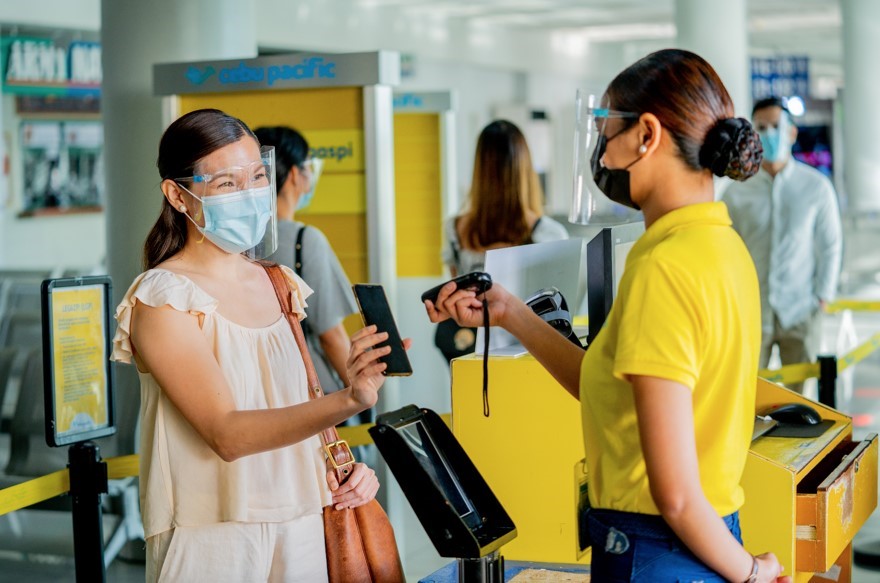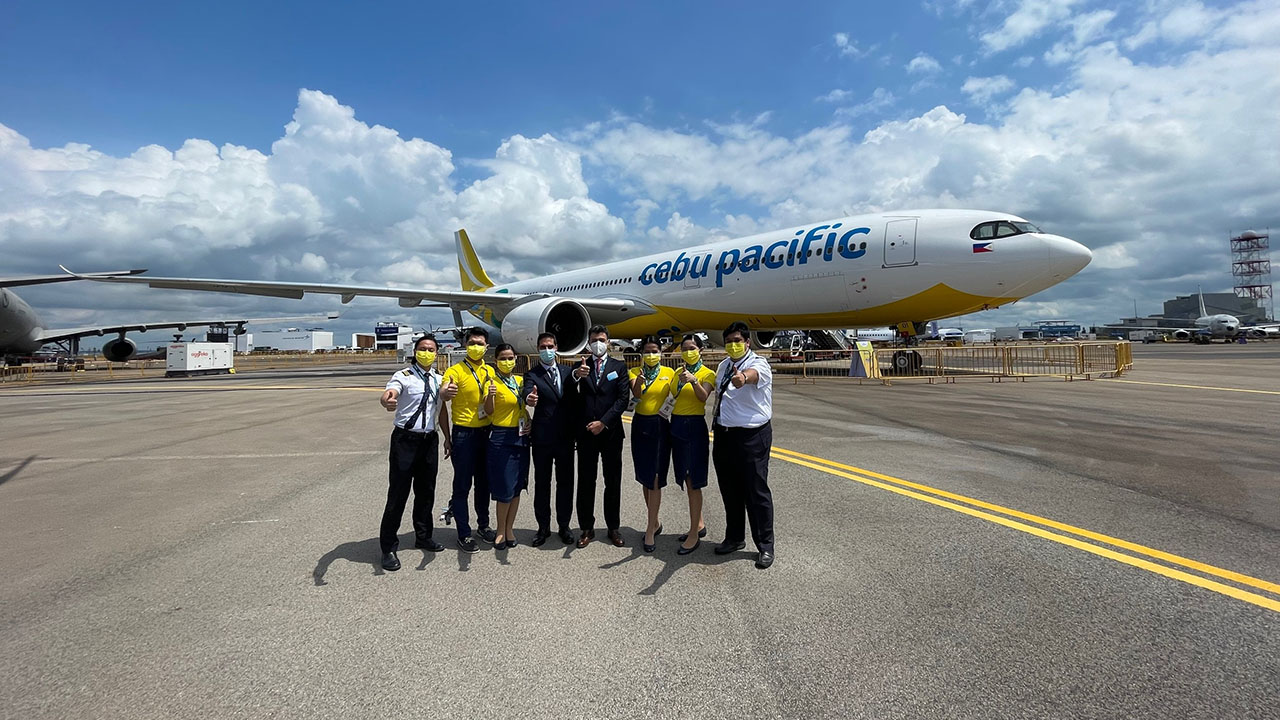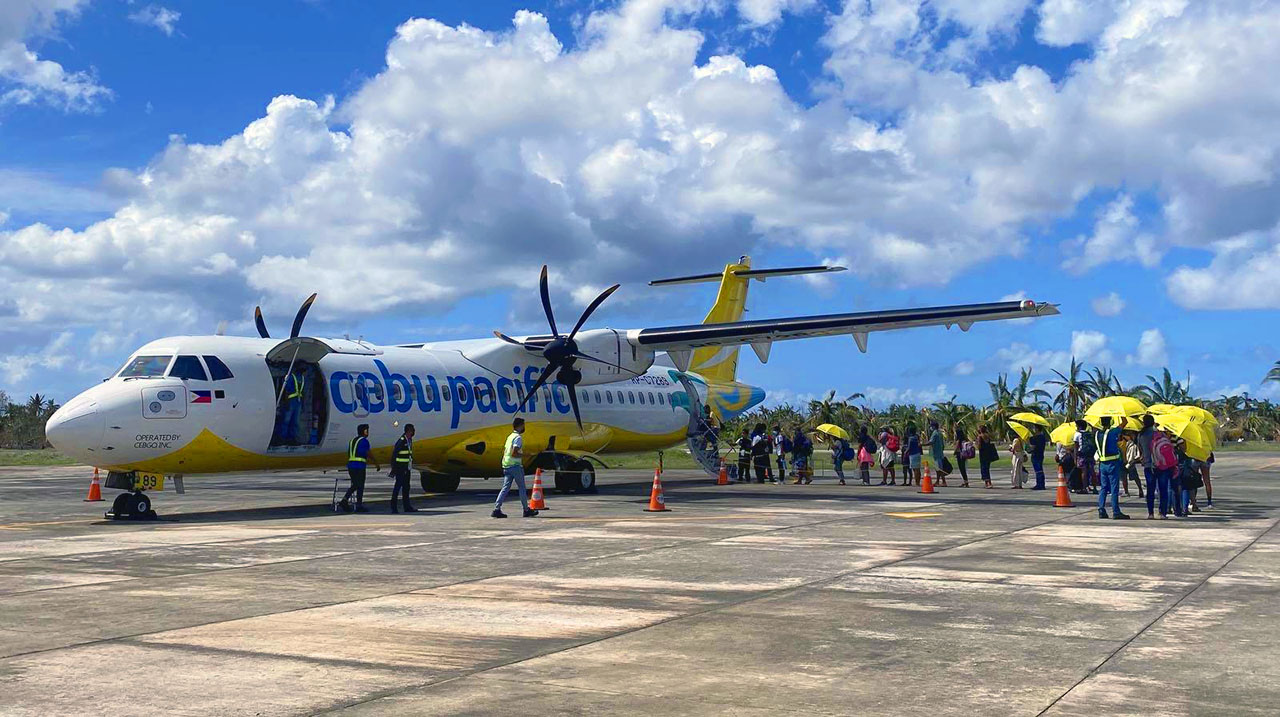As the world rang in a brand-new year, Mark V. Cezar had another reason to rejoice. On January 1, 2022, it became official: he was now Cebu Pacific’s new Chief Finance Officer.
Though he’s barely into his forties, Mark is already a vastly experienced 15-year veteran of the country’s leading carrier. In various capacities throughout the years, he has closed several major business deals not for the faint of heart. “I was still in my thirties, and I was managing transactions that were the equivalent of the GDP of a small country,” says Mark without being the least bit boastful. “I am forever grateful to the leaders of Cebu Pacific especially [President and CEO] Mr. Lance [Gokongwei], just to have been entrusted with that responsibility.”
Preparing to Soar
After earning his Business Administration and Accountancy degree from the University of the Philippines in 2002, Mark joined a prestigious auditing firm for a year before making his mark within the Gokongwei Group. In 2003, he entered JG Summit Holdings as a management trainee and underwent an intensive 18-month training program. During the program, he put in six-month stints at three corporate groups: Robinsons Retail Holdings, Universal Robina Corporation, and JG Summit.

Though each experience helped mold him into the person he is today, the time spent at JG Summit’s Corporate Planning department exposed him to the mentorship of BJ Sebastian, who is now that company’s Senior Vice President for Strategic Investment. “Among my early mentors, he had the biggest influence on me,” shares Mark. “He was technically very proficient, very good at what he did. But he also was, and he still is, of course, a good human being, a good person, someone who cares for his people. I think that had a strong influence on how I eventually defined myself when I was given the privilege to take on leadership roles as well.”
In 2007, when Cebu Pacific asked its parent conglomerate, JG Summit, for potential young leaders that it could tap to strengthen the management team of the fledgling airline, Mark’s name was floated as a possible candidate. After a series of meetings to see if he was a good fit, Mark came onboard in August 2007. “I liked what I saw in the people I met in Cebu Pacific. The organization was dynamic, it was young, and it had a mission I believe in, which is to make air travel become more available and more affordable to more people.”
Spreading His Wings
Mark’s ability to crunch numbers and quickly make sense of complicated data served him well in the task of network planning, which he simply describes as determining which routes to go into. There’s more to it, of course, as during that time, CEB was making the transition into the low-cost carrier model, and choosing which markets to serve would be crucial to its future success. Mark joined CEB as Manager of Network Planning in 2007, before being promoted to Director of Network Planning in 2010, a post he then held for five years.
At this stage in his career, he became more involved with managing the fleet side of the business, tasked to make decisions on ordering aircraft, choosing how many aircraft to maintain in CEB’s fleet, where to fly, and at what frequency to fly.
In 2015, because of his heavy involvement in this aspect of the airline business, Mark was made Director of Fleet Planning. “I focused on the end-to-end process, from the time that we plan for the aircraft, order the aircraft, take delivery of the aircraft, finance it or lease it, all the way to the selling of the aircraft. It's a birth-to-death scope, every step in between. From the time I started handling it, I've lost track already, but I’ve ordered, sold, and transacted billions of dollars’ worth of aircraft.”
He is immensely thankful for having been given a chance at such a daunting task. “To be entrusted with that was very fulfilling. When you see the aircraft actually arriving in Manila, when you finally see the fruits of your work over several years, there's a certain sense of fulfillment that comes with it.”
More personal fulfillment came Mark’s way when Airline Economics, the leading finance and leasing global publication for the aviation sector, placed him on its “40 Under 40” list in 2019. Though he earned recognition as one of the top achievers under the age of 40 in the global commercial aviation industry, Mark is quick to share the plaudits with the entire CEB organization. “It’s a great honor, but it's something I don't claim credit entirely by myself. I think it says much about the work that I do, and I'm grateful that our counterparties — the people I work across at the negotiating table — recognize my professionalism and the way I conduct myself. But it also says much about Cebu Pacific, that it cultivated a corporate culture which empowered me into managing such transactions of such magnitude, and also instilled in me a culture of integrity and professionalism.”
Crisis Management
Mark’s next step up the corporate ladder came in 2020, when he was appointed as Deputy Chief Finance Officer, working directly under the CFO at the time, Andrew Huang, who retired at the end of 2021.
The year 2020, as we now know, would become a nightmare for the world’s travel and tourism industry, and it is still recovering from the pandemic nearly two years later. “It was a crisis of unprecedented proportions for our industry, not just for CEB.”
According to Mark, the very nature of the industry made the situation incredibly difficult to navigate. “If you look at the airline business, it is highly leveraged. We borrow against the aircraft, and we have a very high level of fixed costs. We had to continue to service that even if the inflows in the network, the revenues coming in, were at a fraction over where they were pre-pandemic. We had to maintain and keep paying for a fleet of 75 aircraft, when in reality, we were only flying 15 to 20 of them.”
Mark says that the strong partnerships CEB had forged before the pandemic were key to keeping the airline afloat during the worst part of the crisis, in particular through capital-raising activities that provided CEB with a longer liquidity runway to help it withstand the effects of the pandemic.
“We've raised over a billion dollars of fresh capital for the business. We've done the convertible preferred shares, which JG Summit backstopped. We took a convertible bond investment from external investors, from the International Finance Corporation, which is an arm of the World Bank, as well as Indigo Partners, which is the world's most successful private equity investor in low-cost carriers.
“We also established a Php16 billion, 10-year syndicated loan facility with a group of domestic banks. We've also done various asset-backed transactions to supplement that. That's been highly successful. I don't think there's any other airline in the world of our size — that is not government-owned, that has not been getting bailouts — that has been able to raise that amount of cash through this pandemic,” shares Mark.
Mark is cautious to point out that we’re not completely out of the woods yet, but nevertheless, he says there are many reasons to be optimistic for the future.

“Through the pandemic, I think it is worth noting, that we still are the only airline in the Philippines that's taken delivery of new aircraft. I think that's part of the identity that we've established through this crisis is we've remained committed to our counterparties, to our partners. In that way, we've also been able to get their support as we restructure a number of our contracts.”
When the global health crisis hit, CEB was in the midst of a major re-fleeting program. Despite the current situation, Mark says it is pushing through, although timeliness have understandably been adjusted. “In terms of maintaining a very modern and cost-efficient fleet, that's still central to our business model. We still plan to transition to an all Airbus neo fleet by 2027,” says Mark. The only exception to this modern jet fleet will be CEB’s ATR-72 turbo-prop freighters, which are essential to the airline’s network as they have the capability to land on shorter airstrips around our archipelago not serviceable by jet aircraft. Mark estimates that by 2027, CEB should have a fleet of around 90 to 100 aircraft.
Putting on a Show
When this interview was conducted, Mark had just come back from the Singapore Airshow 2022 and was clearly elated at the reception Cebu Pacific had at the event. It was the first time that Airbus had chosen a carrier from the Philippines to be featured as part of their display at the airshow, and CEB did not disappoint. “I'm proud to say that consistently, among all of the aircraft on display, we saw the longest lines at our aircraft. It was a spectacle. It’s not every day that you see a 459-seat Airbus A330neo,” shares Mark.
Designed by LIFT Aero Design, the cabin interiors proudly reflect the heritage of Cebu province. “It was very on brand. And because of the colors, which represent the sun and the sea, as well as the seats that we chose, it did feel like there were 459 seats in the cabin. We even had very tall guests try the seats out, and they agreed that it was actually very spacious. The room available to each passenger is quite generous.”

Mark makes it clear, though, that this dense cabin configuration is optimized for the carrier’s short-haul international flights. “It’s meant for three- to four-hour flight segments, like to Tokyo or Singapore, that’s the core mission for that particular fleet.” He adds that the aircraft is also flexible enough to take on medium-haul missions, such as Dubai in the Middle East, and Sydney and Melbourne in Australia, in order to cater to certain market segments.
By serving destinations like Dubai, Mark says the airline fulfills the needs of the big Overseas Filipino Worker market, for whom affordability of flights is a major concern. Mounting flights on the A330 is, Mark says, the “best way to cater to that market, to be able to give what they require first and foremost. It's a viable service, it's a safe service. It also allows them to come home at a much lower cost, save money so that they can spend it during their time with their families in the Philippines.”
As CEB modernizes its fleet with more efficient, more environmentally friendly aircraft, Mark says he is also seeing the fulfillment of another goal, that of crystallizing the sustainability and ESG agenda of the airline. “I have a personal sense of responsibility to make sure that Cebu Pacific continues to be considered in this industry as a thought leader, particularly in the aspect of sustainability.”
Hope and the Green Shoots of Recovery
In Singapore, Mark got the chance to interact with Cebu Pacific’s global partners for the first time in person since the pandemic began. “It was refreshing to be able to reconnect with partners and exchange views on what the recovery will look like and how we can continue to support each other as we as we progress,” says Mark.
Through these discussions with his peers in the aviation industry, Mark observed a general sense of optimism, that the worst is finally over. “It truly has been a dreary two years that we've had to labor through, but we are starting to see green shoots of recovery, particularly in this part of the world. The US and Europe, they're nine to 12 months ahead of Asia Pacific in the recovery of air traffic, but here we're finally seeing the borders open up, the travel restrictions easing up. You hear stories like that consistently from partners. It's heartening that we're starting to see the light at the end of the tunnel, and that it's not a train coming at us!”
Best of Filipino Spirit
Cebu Pacific celebrates the values of service integrity, trust, courage, and the best of Filipino spirit. Among these, Mark picks the latter as the one he most strongly identifies with. “In my mind, it means two things. Resilience is number one. Filipinos, we always bounce back from the worst events, the worst tragedies, the worst crises. Personally, my resilience stems from my mantra of doing whatever it takes to deliver what the business needs and what our people need.

“Second, and more importantly, what Best of Filipino Spirit means to me is malasakit [compassion or empathy] for the company, for the people I work with, for our customers, for the country in general. I believe in what Cebu Pacific stands for, its mission to democratize air travel in this country, to make low-cost air travel more affordable to more Filipinos, which in an archipelago like the Philippines, is a highly essential service,” shares Mark. “We're focused on our core mission, and our resolve to get through this crisis and to ensure that we come out of it even more formidable, is stronger than it has ever been.”
For more information on Cebu Pacific, visit cebupacificair.com